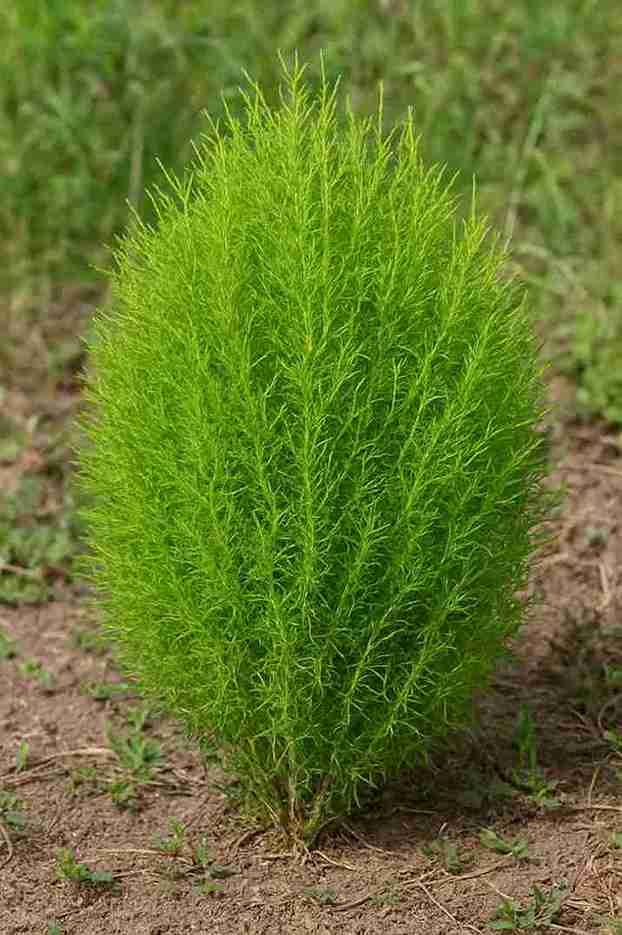
One of the most amazing things about Bassia Scoparia Plant is how its colors change with the seasons. In the summer, it looks like a bright green, delicate shrub with lots of branches, almost like a small evergreen tree.
Bassia Scoparia: Nature’s Vibrant Ally in Beauty, Healing
Bassia Scoparia Plant, also known as Burning Bush or Summer Cypress, is a really interesting and tough plant that has caught the eye of botanists, environmentalists, and landscape designers all over the world. Originally from Eurasia, especially Central and Western Asia, this plant has now made itself at home in many places like North America, Europe, and other parts of Asia.
Types of Bassia Scoparia:
- Bassia scoparia ‘Trichophylla’
- Bassia scoparia ‘Flame’
- Bassia scoparia ‘Childs’
- Bassia scoparia ‘Burning Bush’
- Wild Type (Standard Form)
🌿 1. Bassia scoparia ‘Trichophylla’:
This is the most popular and widely grown type, often called “Summer Cypress.” It has a really neat, cone-like shape that makes it great for decorative planting. In the summer, its leaves are a bright, lively green, but when autumn arrives, they turn into a gorgeous red, which is why so many people love using it in seasonal garden designs.
🔥 2. Bassia scoparia ‘Flame’:
True to its name, this variety is famous for its super bright, deep crimson-red color in the fall—it’s like it’s actually “on fire.” It’s often used in landscaping, especially in parks or public gardens, where you want something with bold color to stand out in the autumn.
🌱 3. Bassia scoparia ‘Childs’:
This is a smaller, bushier type that’s perfect for tight spots, like small gardens, borders, or even pots. It has a softer look thanks to its dense, fine leaves. Gardeners tend to choose this one when they want a tidy look without the plant getting too big.
🔥🌈 4. Bassia scoparia ‘Burning Bush’:
This one gets its name from its stunning red to purple leaves in the fall. It really makes a statement in gardens and landscapes, almost looking like it’s glowing or on fire. It’s ideal for making a big visual impact later in the year.
🌾 5. Wild Type (Standard Form):
During the summer, it usually sports a green color, but as autumn arrives, it transforms into a beautiful brownish-red hue. While it might not be as flashy as the cultivated varieties, this wild form is incredibly useful for improving soil quality, preventing erosion, and can even serve as food for livestock in certain areas.
How it use in cooking-
| Culinary Use | Description |
|---|---|
| Young Shoots (Raw or Cooked) | Tender young leaves and stems can be used as a green vegetable, especially in Asian cuisine. |
| Boiled Leaves | Commonly boiled and served as a side dish in rural regions, especially in Japan. |
| Ingredient in Soups & Stews | Adds a slightly salty, earthy flavor; used in traditional medicinal soups. |
| Pickling | Young shoots can be pickled and preserved for later use. |
| Traditional Japanese Dish – Tonburi | The seeds of Bassia scoparia (from a specific variety) are processed and eaten, known as “Land Caviar” in Japan. |
Use in skin care-
| Part Used | Skin Care Use | Common Applications | Notes |
|---|---|---|---|
| Leaves (Extract) | Anti-inflammatory agent | Creams, lotions for rashes and redness | Helps calm irritated or inflamed skin |
| Leaves (Boiled/Soaked) | Herbal bath soak | Added to bathwater for skin relaxation | Used in traditional skincare rituals |
| Whole Plant (Herbal Mix) | Natural detox remedy | Body scrubs, herbal face masks | Believed to purify skin by removing toxins |
| Leaves (Paste) | Acne treatment | Applied on acne-prone areas | Antibacterial properties help reduce pimples and breakouts |
| Leaf extract | Itch relief | Ointments or homemade salves | Traditionally used for eczema, rashes, and insect bites |
also visit- The Rose Plant: Beauty, Benefits, and of Nature’s Queen
Use in Medical Care-
| Part Used | Medicinal Use | Common Applications | Notes |
|---|---|---|---|
| Whole Plant | Diuretic | Herbal teas, decoctions | Promotes urine flow; used in traditional systems to relieve water retention |
| Leaves | Anti-inflammatory | Herbal poultices, decoctions | Used to reduce swelling, joint pain, and skin inflammation |
| Seeds | Liver Support | Tonics, liver-cleansing formulations | Believed to aid in detoxification and improve liver function |
| Whole Plant Extract | Antibacterial/Antifungal | Topical applications, herbal washes | Used on wounds, infections, and fungal issues |
| Roots | Blood Purifier (Traditional) | Included in traditional herbal blends | Used in Ayurveda and folk medicine for detoxifying the blood |
Conclusion-
In the world of medicine, Bassia scoparia plant has a long history in folk healing, often serving as a diuretic, a liver tonic, and an anti-inflammatory remedy. It’s commonly prepared as teas, decoctions, or poultices. Its wide-ranging benefits for detoxification, skincare, and overall well-being really show how much more it offers than just good looks. So, Bassia scoparia definitely stands out as a one-of-a-kind, multi-use plant that boasts both beautiful appeal and deep cultural and health importance.






Gulmohar Tree: A Stunning Summer Bloom with Ecological Value - Panda Pandi